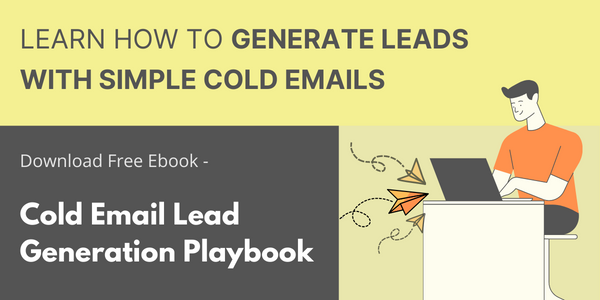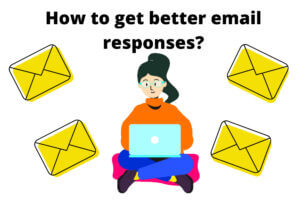Cold emails are widely used in many different kinds of campaigns. But this widespread use of email channel also creates a lot of noise. How do you stand out from the noise and get more email responses?
Through the fire of marketing looming large, emails remain the most common and trusted means of communication. A well written cold email can get you clients, joint venture plans and other business profits.
But many cold email marketers make some serious mistakes, not getting a lot of responses to their cold emails.
If your email outreach is not performing as it should, remember: the problem may not be with the email channel, but with the way you’re writing your cold emails.

How to get responses to your cold emails
1. Keep your emails short, crisp and clear
Longer emails are more difficult to read. A reader has to put more effort to understand them.
Think about it, do you like to read yard long emails yourself? The answer, in all probability, is no. So what makes you think that others will like to read it?
People don’t enjoy reading long emails. If they see a long email from a stranger, they will very likely just ignore it.
So if you want people to read and respond to your emails, keep them short and crisp, say 5-8 lines or less than that.
Also for starters do not add the entire list of benefits you are going to offer. Just add the top two or three features so that your clients don’t get bored.
If you have not received a proper response to your cold emails, maybe they were too overwhelming for your clients. In that light keep the necessary information and trim the rest away.
2. Write with a personal touch
Here is a rule of thumb, your emails should have a personal tone if you wish to draw the attention of the clients and readers. But how to sound human so that you get email responses?
Of course, you don’t know them personally so asking how was their weekend is probably not a good idea however once you have interacted enough!
You can, add a personal touch by sharing some interesting news about their industry or you can state something unique about their company to show that you understand their business model.
People like being valued and if you can show them the same it will make a difference. Do your research about the company and state your findings smartly.
A personal tone to your emails will help in building some familiarity and trust in your relationship with the audience. That trust will eventually nudge them to start responding to your cold emails.
3. Don’t be afraid to follow up
You might be telling yourself, “Oh, I already emailed them” or “I don’t want to bother them again.” Falling prey to this thinking could cost you sales. Don’t be afraid to send more messages – more often than not your prospects will thank you for the reminder.
Follow your leads on social media. Engage with their content, leave comments. They will surely remember you.
Timing your follow up email correctly is vital. You don’t want to write too frequently. But at the same time, you don’t want to just slide off from their memory.
Most people are busy and lose track of the things they have to do. That’s why they create to-do lists and reminders. So why shouldn’t you remind them about your email?
4. Insert strong visual elements
Visual elements like – images, infographics, charts etc. are very powerful channels to easily communicate information that is otherwise complex.
Visuals are very important and popular in content marketing. They are widely used in blogs, social media posts and also in emails. GIFs can provide very powerful visuals in emails.
Creating an infographic about the milestones achieved by the business or a case-study carried out by some of their researchers are some good examples of adding a visual touch to boring email bodies.
Adding pictures to your content makes the content more tangible. In other words, the readers can actually “see” what is being talked about.
5. A precise call to action (CTA)
Many salespeople end their emails with ”Let me know if I can help.” But what does that really mean? When you’re sending a cold email to someone, leaving it open ended like that is a bad idea.
Give them an easily actionable way to get back to you. Don’t beat around the bush. Be clear and direct about what you’re asking for.
Instead of “I’d love your feedback,” ask “When’s a good day this week for a 15 minute call to discuss?”
6. Always test your emails
Many email marketers send outreach emails, but never test them.
You might be repeating the same mistake over and over again and you don’t know why you’re not getting responses. Knowing what doesn’t work well will help you to change it, become better and evolve.
The most standard and basic email tests are A/B tests. You should select just one variable you want to test in order to get the most accurate results.
Here is a complete guide on how to A/B test your emails.
Every audience is different. Testing your email content, subject lines and CTAs for different audiences will help you to understand what ticks for each of these groups. Then keep on improving your emails on the same lines to get more responses.
7. Reach the right audience
You have to know your prospects to make sure you’re reaching the right people. This is true for any marketing campaign.
A common thought process is that to make business/sales you have to reach the final decision maker. While this may be true in some situations, it isn’t in most, especially in B2B sales and marketing.
Companies have several individuals that handle different areas of the business. You’ll get better results by reaching the person in charge of the department that corresponds to your area of business.
It may help to check your mailing list and analyze if you are indeed targeting the right people – decision makers as well as influencers – for your sales.
Conclusion
Email outreach is one of the easiest and most effective ways to grow your business. But these tips will help you to get more email responses.
You can also use these cold email templates as a starting point for your own campaign. Start with the plain template, then improvise them following the tips that we just looked at. Additionally, follow these best practices for writing and sending cold emails, to ensure improved deliverability as well as engagement.
Even though many of us are drowning in e-mails and would like to see less of them, e-mail is still the number one platform for generating sales – as long as you manage to get email responses.
No other platform has conditioned us to expect messages from complete strangers and actually respond as well.


Leave a Reply